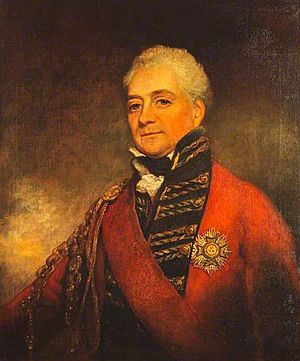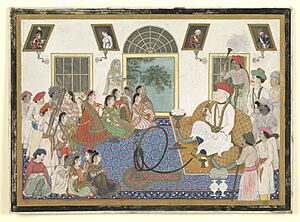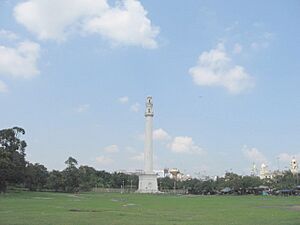David Ochterlony facts for kids
Quick facts for kids
Sir David Ochterlony
GCB Bt
|
|
|---|---|

Portrait of Ochterlony by Arthur Devis, c. 1816
|
|
| Born | 12 February 1758 Boston, Province of Massachusetts Bay, British America |
| Died | 14 July 1825 (aged 67) Meerut, Bengal Presidency |
| Buried |
St. John's Church, Meerut
|
| Allegiance | East India Company |
| Service/ |
Bengal Army |
| Years of service | 1778–1825 |
| Rank | Major-General |
| Commands held | 2nd Battalion 12th Bengal Native Infantry Resident at Delhi Allahabad Garrison Ludhiana Garrison Third Field Division Field Army, Nepal Division protecting Delhi Resident at Rajputana Commissioner-General, Rajput states Resident at Delhi Resident at Malwa and Rajputana |
| Battles/wars | |
Major-General Sir David Ochterlony, 1st Baronet (born February 12, 1758 – died July 14, 1825) was an important military officer. He was born in Massachusetts, which was then part of British America. He worked for the East India Company in British India. He held a very powerful position as the British representative, called a Resident, at the Mughal court in Delhi.
Contents
Biography
Early Life and Start in India
David Ochterlony was born in Boston, Massachusetts. He was the oldest son of Captain David Ochterlony and Katherine Tyler. His father's family came from Scotland, and his mother's family was from England and Wales. David went to school in Boston.
In 1777, when he was 18, Ochterlony traveled to India. In February 1778, he became an ensign in the Bengal Native Infantry. By September of that year, he was promoted to lieutenant.
Military Career and Key Battles
In June 1782, Ochterlony was serving in the Second Anglo-Mysore War. He was injured and captured by the forces of Haidar Ali. He remained a prisoner until the war ended in 1784. After his release, he returned to Calcutta. For his service, he was made a Judge Advocate-General for part of the army. He became a captain in 1796 and a major in 1800.
In 1803, he was promoted to lieutenant colonel. He joined Lord Lake during the Second Anglo-Maratha War. He was part of important battles like Koil, Aligarh, and Delhi. After the Battle of Delhi, he became the British Resident in Delhi. In 1804, he bravely defended Delhi with a small force against an attack by Yashwantrao Holkar. This earned him great praise. He then commanded forces in Allahabad and later near the Sutlej river to stop the expansion of the Sikhs. He became a Major-General in 1814.
When the Anglo-Nepalese War began in 1814, Ochterlony led one of the main forces. His column was the only one that was truly successful in the war. He was then put in charge of the main army advancing on Kathmandu. He outsmarted the Gurkhas by a clever flank march. This led to the end of the war and the signing of the Sugauli Treaty, which set the future relationship between the British and Nepal.
Honors and Later Service
For his success in the war, Ochterlony was given a special honor: he became a Knight Commander of the Bath. This was the first time an officer in the British military in India received this honor. He also received a special title, a baronetcy, in November 1815. The next month, he was given a pension of £1,000 each year.
In December 1816, he received an even higher honor, becoming a Knight Grand Cross of the Order of the Bath. In 1818, he was appointed Resident in Rajputana. This role was later combined with the Delhi Residency. During the Third Anglo-Maratha War (also known as the Pindari War) between 1818 and 1819, he commanded a force in Rajputana. He made a separate agreement with Amir Khan, separating him from the Pindaris. He then positioned his forces between the two main enemy groups, ending the war without a major battle. After this, he became the Resident and Political Agent of Malwa, overseeing all matters in central India.
Final Years and Legacy
In 1825, a revolt broke out in the state of Bharatpur. Ochterlony supported the young ruler, Balwant Singh, and sent troops to help him. However, the Governor-General of India, Lord Amherst, disagreed and ordered the army to return. Ochterlony was very upset by this decision. He resigned from his position and moved to Delhi. He was replaced by his friend Sir Charles Metcalfe. It is believed that the feeling of not being trusted after his many years of service made him ill. He died in Meerut in July 1825 and was buried in St. John's Church, Meerut.
The Ochterlony column in Calcutta was built to remember him, though it has since been rededicated.
Private Life

As the official British Resident in Delhi, David Ochterlony adopted many aspects of the local Indo-Persian culture. He was known to have several Indian partners or wives. It was said that every evening, he would take his thirteen wives on a parade around the walls of the Red Fort, each riding her own elephant.
Mubarak Begum
One of Ochterlony's most important partners was "Bibi Mubarak-ul-Nissa Begum." She was reportedly his favorite and was the mother of his two youngest daughters. She was known as "Generallee Begum" and held a very important position in his household. She was a devout Muslim and even asked for permission to go on the hajj pilgrimage to Mecca.
Mubarak was younger than Ochterlony, but she was seen as a very strong person in their relationship. Some people even said that making Sir David the Commissioner of Delhi was like making Generallee Begum the commissioner. Because of her influence, Ochterlony considered raising his children as Muslims. When his two daughters with Mubarak Begum grew up, he adopted a child from a leading Muslim family in Delhi. This adopted girl was raised by Mubarak and later married her cousin, who was a nephew of the famous Urdu poet Mirza Ghalib.
Mubarak Begum even seemed to act like a powerful figure on her own. She was reported to be involved in diplomatic dealings, which was unusual for someone in her position. However, despite her power, Mubarak Begum was not very popular among either the British or the Mughals. She upset the British by calling herself "Lady Ochterlony." She also upset the Mughals by giving herself the title "Qudsia Begum", which was usually only used for the Emperor's mother. After Ochterlony's death, she inherited Mubarak Bagh, a garden tomb he had built.
Children
Ochterlony had at least six children with his partners:
- Roderick Peregrine Ochterlony (1785-died by 1823), his only son. He married Sarah Nelly in 1808. Roderick and Sarah Ochterlony had three children.
- Sir Charles Metcalfe Ochterlony, 2nd Baronet (1817–1891). He inherited his grandfather's title in 1825. He married Sarah Tribe in 1844 and had three sons and two daughters. This special title ended when the fifth Baronet died in 1964.
- Charlotte Ochterlony (died 1835)
- Two daughters with Mubarak Begum.


